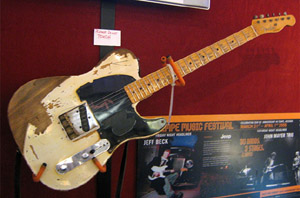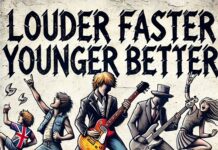By Andrew Todd
Pick up any timeless rock and roll recording – put it on your turntable, slip it in your CD player or tape deck, and chances are better than good that the sound you hear will meet two criteria: 1) the guitar defines the music; 2) The music was created by a guitar from one of the Big Three.
The “Big Three,” of course, are the Fender, Gibson, and Martin guitar companies – manufacturers who defined the instrument in its present incarnation and who all other manufacturers copy to a lesser or (more likely) greater extent. The companies are so synonymous with rock and roll that their products have become icons in their own right.
What says rock and roll louder than a Gibson Les Paul? Nothing, that’s what. What is the most versatile instrument in the rock-o-sphere? The Fender Stratocaster, of course. And which sound box hands-down defines the unplugged tones of popular music for the last 50 years better than the Martin D-18? There isn’t one. Go look, if you want to.
With this in mind, it’s not surprising that these three companies were well represented at a trade show that, despite its best intentions to cover the entire musical spectrum, most often comes off as a four-day mixer for the rock and roll elite, the fashion and hygiene deficient, and the entire groupie gene pool.
Having said that, it was interesting to see the approach each company took in presenting its wares for 2006.
Fender: Nothing Says Success Like Excess
Upon entering the Fender booth (if “booth” is, indeed, an accurate term for the metropolis the former Fullerton, CA company constructed on the second floor of the Anaheim Convention Center), my first thought was, “showoffs.” To celebrate their 60th year, these guys lined the walls with product and stacked them to the ceiling; row upon row of their signature instruments and amplifiers. Everything from the working man’s Telecaster to the latest Custom Shop Strat was on display. And now that Fender owns smaller guitar makers like Guild, Gretsch, and Charvel, they can pretty much be summed up as the General Motors of the guitar industry.
As with most instrument companies today, Fender relies on star power to help sell instruments. Unlike automobiles, computers, and other consumer products, instrument technology is relatively stable and doesn’t advance very quickly. In order to get the attention-deficient masses interested in purchasing products, a little celebrity goes a long way, and Fender has quite an arsenal at its disposal. Just about every famous musician has played a Fender guitar or played through a Fender amplifier. If not, they’ve probably played one of Fender’s associate products.

Take a guy famous for playing Fender knock-off guitars in his heyday, for instance. Eddie Van Halen’s signature Kramer was an icon in itself in the 80s, a symbol of blistering 32nd notes and volume cranked to “11”. Now they are building knock-offs of the original knock-off: the Charvel EVH. It looks as good today as it did back in the heady days of spandex and hairspray.
In most cases, “signature” models are nothing more than stock instruments with a few minor details thrown in at the artist’s request: Buddy Guy’s pink polka dots, John Mayer’s racing stripe and custom frets, Eric Johnson’s hand wiring and custom neck. But I think we can all tip our collective hats to Jeff Beck for truly redefining the signature model. The replica of his road beaten and abused Telecaster can only be described as… unique? Fender techs faithfully reproduced the sad-looking axe (presumably by dragging it behind one of Beck’s hot rods before giving it the once-over with an acetylene torch). This one-of-a-kind piece will not be put into production, but it does set a fine example of the guitar community’s love for the well used, as we would see again and again at the show.

While vintage guitars are the order of the day at Fender, the opposite can be said of their amplifiers. While some players will never settle for less than the sound of a Fender amp from the 50s or 60s, amplification is one area that has experienced some revolutionary changes in the past few years, and Fender is among the leaders in this area.
The newest incarnations of Fender’s Cyber-series of amplifiers mix the sought after sound of real tube amplification with cutting edge digital modeling schemes, giving players a virtually endless selection of virtual guitar sounds in one combo-sized amp. During a demonstration of the newly revamped 130-watt Cyber-Twin, the rep on hand jumped from Jimi Hendrix to Stevie Ray Vaughan to Mark Knopfler to David Gilmour to blistering heavy metal to ethereal textured sounds, all without ever taking his hands off of the guitar. With a footswitch he was able to get any sound he could think of, instantly; at least it seemed that way.
Along with their faithful recreation of the classics that put them on the map, Fender’s new series of digital amplifiers offers some of the most exciting developments for guitar players in years.
Gibson: Have Appointment, Will Travel
The folks at Gibson took a more exclusive approach to displaying their products at NAMM this year. Visitors were only permitted into the inner sanctum by appointment, and the general masses were blocked from accessing their showcase until the final day of the show. Needless to say, I felt pretty exclusive myself as I was led into the showroom to review their products for 2006.
As you would expect, the stars were out in force at the Gibson booth. Signature Les Pauls for Billy Joe Armstrong, Peter Frampton, John Sykes, and Kiefer Sutherland – Yes, that Kiefer Sutherland – were on hand, in addition to a tribute to Jimi Hendrix and his far-out Flying V. Legend has it that he painted the psychedelic imagery on the body with his girlfriend’s nail polish. The folks at Gibson seemed to have captured every detail of the original.

Just as stone-washed blue jeans took the world by storm in the 80s and 90s, broken-in guitars seem to be high fashion today. In addition to the Sykes model (sold brand new with exposed wood and missing pieces), the Memphis-based company is now delivering all of their reissue guitars in “hand-aged” condition. Why wait 30 years for that neck to feel “played-in” and that beautiful patina to develop when Gibson will have one of their master luthiers do the job for you? And you don’t have to pay five figures to get it, either.
Regardless of your opinions on “brand new” versus “looks old,” there can be no arguing over the quality and beauty of a reissued Les Paul, SG, ES-335 or other classic guitar.
On the other side of the aisle, Gibson displayed some models that do show that they are focused on the future, as well as the past, with their instruments. The new GT series of instruments is designed for professional players and offers features that their vintage instruments do not. These Les Paul and SG models are more rugged than their standard instruments and include specialized electronics and controls that give the working player a wider variety of sounds than their traditional counterparts. In addition, Gibson is now building guitars designed “by female players for female players.”

Zakk Wylde signature model Les Pau
After much research and feedback from the growing female guitar playing demographic, Gibson has designed a new Les Paul model that sports features specifically designed for women. Rick Bos, Gibson’s sales manager, points out that the instruments feature “shorter scale lengths and a slimmer neck to accommodate small hands, a comfy contour in the back (a la the Fender Stratocaster), and a lighter body all make for an axe that is ideal for young players and ladies alike – although these guitars play so nicely that anyone would like them. They also come in new colors that satisfy the female sensibilities.” The sound, however, is undoubtedly Les Paul.
Out in Montana, Gibson makes a fine collection of acoustic instruments, some of which have been defining rock for years. Several new models, including signature instruments for Emmylou Harris, Sheryl Crow, and Pete Townshend, were on display and their sound is unique and striking.
Speaking of acoustic instruments…
Martin: Fresh Faces On Old Acquaintances
The folks at the Martin Guitar Company never cease to amaze me. While they are, admittedly, selling a product that they more or less perfected three quarters of a century ago, they still manage to bring something new to the table every year, making their collection fresh and interesting.
Like their industry counterparts, the Nazareth, PA guitar maker also sports their share of star power with new signature models by such artists as Eric Clapton, John Mayer, Andy Summers, and Richie Sambora. And, despite the fact that each instrument is essentially a variation of their original jumbo and dreadnought acoustics, each provides its own unique set of features that make the model appealing to the player or collector with a few grand to drop on a fine guitar. The Buddhist-inspired inlays on the Andy Summers model where especially eye-catching.
Another interesting showpiece is the POW-MIA inspired guitar that was built to honor America’s military heroes who were held in captivity or are still missing in action.

a five figure price ta
“To those we have lost, you are not forgotten” is the theme that inspired the beautifully constructed black instrument that features, among other things, detailed mother-of-pearl fretboard inlays and a slick stars-and-stripes lined case. Some proceeds from the sale of this special-issue instrument go toward the National Alliance of Families for the Return of America’s Missing Servicemen and Women.
Additionally, Martin continues to look back with some stunning featured instruments, including a D-45 that was rescued and completely restored. For a mere $45,000 it could be yours… except that it sold the first day of the show. This glossy dreadnought features a rare (nowadays) Brazilian Rosewood neck and appointments, which made it a hot item for collectors.
For the budget-minded, Martin offers instruments that are built to the same standards as their high-end guitars, but with laminate or composite woods and alternate materials to keep costs down. Despite the trade-off in wood, these guitars sound just like a Martin – rich and punchy – and play very nicely.
Timeless Icons That Define Timeless Rock ‘n’ Roll
In spite of the fact that each of the “Big Three” have been around for more years than Keith Richards’ nicotine habit, they still bring fresh and interesting products to the market every year – even if those products are often just modified versions of the original classics. But it’s the classics that we all look for (they’re classic for a reason, after all) and, to end this rambling report with a classic cliché: If it ain’t broke, don’t fix it. Just get a famous rock star to sign the headstock, put a schwanky new finish on it, or beat the hell out of it and sell it to that image-conscious, thirty-something-with-a-couple grand to burn. All in the name of Rock ‘n’ Roll…
![]()




















